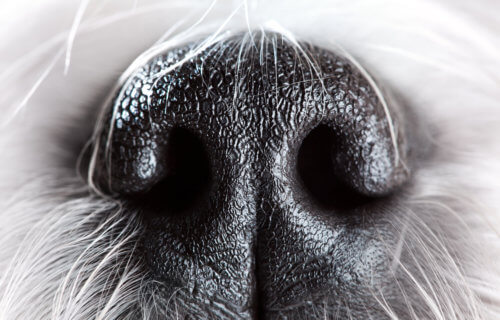CAMBRIDGE, Mass. — Man’s best friend holds the key to earlier diagnosis of the most common cancer in men, say scientists. Dogs can detect prostate cancer tumors in urine thanks to their amazing olfactory powers. Now a team of scientists from the U.S. and U.K. have harnessed these powers into a computer learning, or artificial intelligence, program.
The National Cancer Institute estimates 248,530 new cases of prostate cancer and 34,130 deaths from the disease among men in the U.S. this year. Now, new technology under development in the form of a smartphone app “sniffs out” prostate tumors. The device is based on dogs’ remarkable sense of smell.
“We’ve shown it’s possible to replicate the dog’s performance as sensors and brains,” says study lead author Dr. Claire Guest of Medical Detection Dogs in Milton Keynes, England, in a statement per South West News Service. “It’s now time to put this technology in every smartphone.”
The breakthrough offers hope of cheap and simple screening. Prostate cancer is the second leading cause of cancer death in American men, per the American Cancer Society. The widely used prostate specific antigen (PSA) screening test can miss aggressive prostate cancer, or suggest it’s potentially deadly when it poses little risk.
Training dogs to detect cancer takes time and availability is limited, making them impractical for large-scale screening. In experiments, a miniaturized detector system that can be incorporated into a smartphone was as successful as a dog. The device incorporates mammalian olfactory receptors stabilized to act as sensors. The data streams can be handled in real-time by a typical smartphone’s capabilities.
In testing the same 50 samples of urine from patients diagnosed with prostate cancer and individuals free of the disease, the device matched the success rate of dogs. It was more than 70 percent accurate, just like trained dogs Florin, a four-year-old female Labrador, and Midas, a seven-year-old female wire-haired Hungarian vizsla.
AI technology in smartphone app is 200 times more sensitive than a dog’s nose
Dogs can detect many kinds of disease simply through smell, ranging from lung-, breast-, ovarian-, and bladder cancers to COVID-19. In some cases, they are 99 percent successful in detecting prostate cancer from patients’ urine.
The artificial system is actually 200 times more sensitive than a dog’s nose in terms of being able to detect and identify tiny traces of different molecules. But in terms of interpreting those molecules “it’s 100 percent dumber,” explains co-lead author Dr. Andreas Mershin of the Massachusetts Institute of Technology (MIT) in a statement.
“The dogs don’t know any chemistry. They don’t see a list of molecules appear in their head. When you smell a cup of coffee, you don’t see a list of names and concentrations, you feel an integrated sensation. That sensation of scent character is what the dogs can mine,” says Dr. Mershin.
Machine learning finds the elusive patterns dogs can infer from the scent that humans haven’t been able to grasp from a chemical analysis. “We knew the sensors are already better than what the dogs can do in terms of the limit of detection,” explains Dr. Mershin. “But what we haven’t shown before is that we can train an artificial intelligence to mimic the dogs, and now we’ve shown that we can do this. We’ve shown that what the dog does can be replicated to a certain extent.
“The system is small enough to fit in a smartphone,” Mershin adds. He hopes to be able to test a far larger set of samples, perhaps 5,000, to pinpoint in greater detail the significant indicators of disease.
This study is published in PLOS One.
SWNS writer Mark Waghorn contributed to this report.
